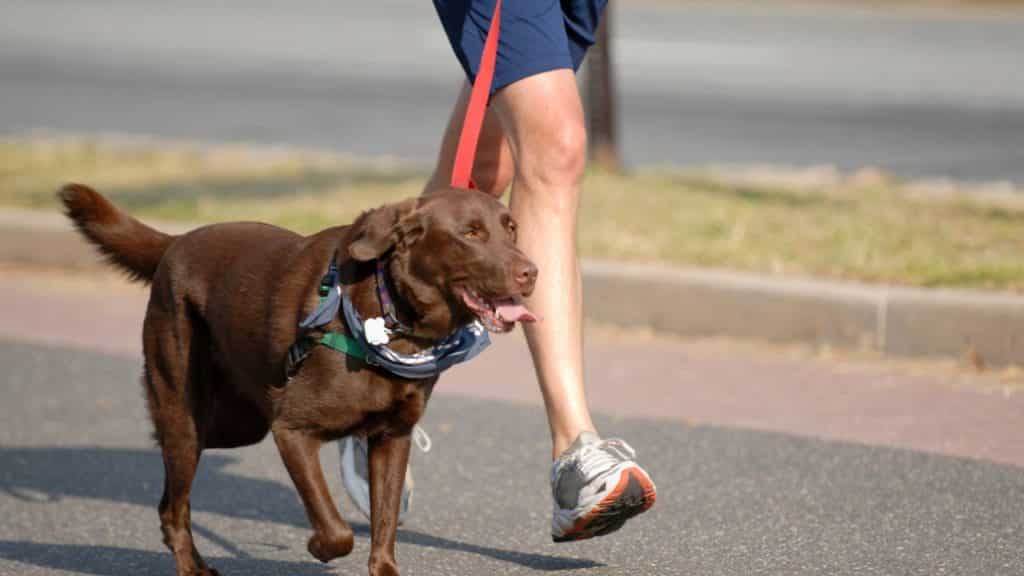
Do you find that your dog prefers to pull you rather than follow?
Have you tried teaching them to walk on a leash, but they still do not listen?
The reason might be as simple as the type of collar or harness that you are using. Changing collars and harnesses can make all the difference in how your pup reacts when walking with their leash.
If your dog likes to drag you on walks, it could be because they’re bored.
Here are some ideas for how to make the walk more fun for both of you!
- 1) Try playing games like “I Spy” or “Find Something New.” These types of activities will help your dog stay focused and not get distracted by other things in their environment.
- 2) Change up the route every once in awhile so that there is always something new to see and smell.
- 3) Invest in a harness with a front leash attachment point – this way you can lead your pup instead of being pulled along behind them.
- 4) Get creative! You might want to try teaching tricks, or picking up trash while out on walks together (at least until you have your pup’s complete attention).
For more tips on improving your walk, check out this post from our friends at Pets In Review!
If you’re having trouble training your dog to walk correctly, contact a professional pet behaviorist or trainer for assistance. It may not seem like it at the moment, but when you find the proper training method, you’ll find that walks will be even more fun for both of you!
Why Do Dogs Drag You on Walks (The Reasons)?
It may be challenging to walk your dog as he drags you along the sidewalk. However, because it seems like all dogs love to do this, we will discuss why dogs carry their owners on walks and provide tips for training a dog not to pull on his leash.
First of all, you must understand that by dragging you around the sidewalk, your dog is trying to lead you.
He wants you to follow him, but he does not want to be by your side.
Dogs are members of the family that love to take charge. This type of behavior is prevalent if they have grown up with a single owner or if their owners are often around but not very hands-on.
1. Dragging You Gets Them Places Faster
Dogs are faster than humans because they have four legs. So dragging you around will get your pup from Point A to Point B faster, and it may even entertain him.
If you want your dog not to drag you on walks, make sure you do not give in and follow after him when he starts to pull. Instead, stand still and wait for him to come back to you.
Please give him a treat when he comes and start walking in any direction, but he wants to go in.
2. Dragging Gets Them Attention
If your dog does not lead you on walks and tries to stay close by your side, he may be trying to tell you something.
Your dog may want your affection while you are walking. He might try to get your attention by moving around and pulling on the leash until you acknowledge him. Then, he will have gotten what he wants without resorting to annoying behaviors like barking or jumping up on people if you give in.
If your dog does not lead you when walking, make sure you do not give in and pay attention to him. It is good to pet your dog off the leash, but you must let him know that he cannot demand affection.
3. They Don’t Know What They Are Supposed to Do
If you have recently decided to take your dog for a walk, he might not know that he should be next to you.
Your dog may think that you are taking him on his first-ever walk and will try to figure out the rules as he goes along. He might even stop moving if he cannot figure out what is expected of him.
4. Dogs Are Fast!
You might be able to run faster than your dog, but he can out-sprint you by far. If your dog is constantly pulling you around on walks, it could be because he has too much energy and needs to burn it off.
Make sure you do not overwhelm him with the length of the walk. For example, instead of taking him for a long walk every day, break it into two shorter walks.
Also, make sure your dog gets enough physical exercise in other ways, such as playing fetch or going to doggy daycare.
5. Other Dogs Are Around
If other dogs are around while you take your pup for a walk, he might get too excited. This excitement might compel him to pull you towards the other dog.
Make sure your dog is on a leash before passing another pooch if he spends too much time around other dogs while off-leash, try to avoid them while taking him for walks.
6. Your Dog Is Scared or Anxious About Something
If your dog can smell scary or dangerous things on walks, he might get anxious.
Your dog may try to move you towards the source of his anxiety so he can get away from it. Please make sure there are no smells around that might frighten him while taking him for walks.
7. You Are Pulling Him in the Wrong Direction
If you are pulling your dog in the wrong direction during walks, he might pull back.
You may think that the way you are walking is the way home when in reality, it is not. Also, if your pup knows how to get somewhere else, like a park or dog daycare, he might be trying to take you there instead of home.
If you cannot get your pup to stop pulling on walks, try picking up the leash and moving in the direction you want to go. After a few steps, stop and do not keep walking until he stops pulling again. He should eventually learn that if he does not move with you, he will be standing still.
8. You Don’t Have the Right Tools for Training Your Dog
If your dog is a professional escape artist, it might be because you have not invested in the right equipment.
Make sure that your dog is wearing a collar and leash that fit correctly before going for walks. If the leash keeps slipping out of your hand, try using a harness instead of a collar. It will be easier to keep your dog in place.
Also, make sure to use treats when training your pup not to pull on the leash so he can see that good things will happen if he walks appropriately.
If you are still having trouble getting your pup to stay close during walks, consider stopping the behavior by using an electric shock collar.
9. Your Dog is too Tired
If you walk your dog in the evening when tired, he may not have enough energy to keep up with you.
It is usually best to walk your pup during his peak energy hours, generally in the morning. If possible, take multiple short walks instead of one or two long ones.
Walk the Dog With the Right Harness (No Pull Dog Harness)
Harnesses are not all created equal. A no pull dog harness can be far better than a traditional flat collar, especially for dogs who tend to pull.
A harness will help evenly distribute pressure across your dog’s chest, which means that it is much less likely that they’ll end up coughing or choking themselves like they might if you use a collar.
Additionally, a no-pull dog harness is much easier to grab if you need to stop your dog from whatever they’re doing quickly.
Harnesses that have clips on both sides of the chest also help prevent dogs from wiggling out of their collars or harnesses – something that can happen when there’s only one attachment point.
The harnesses that we’ve chosen are all well-designed, durable, and versatile. They should last for many years if cared for properly.
